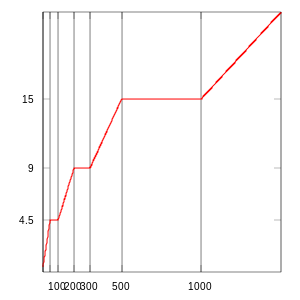Estimated sign


The estimated sign, ℮, also referred to as the e-mark or "quantité estimée" (Unicode U+212E), is a mark that can be found on some pre-packed goods in Europe. The estimated sign indicates that the packaging fulfils European Union Directive 2009/34/EC.[1]
The scope of the directive is limited to packaging that has a predetermined nominal quantity of 5 grams (0.18 oz) to 10 kilograms (22 lb) or 5 millilitres (0.18 imp fl oz; 0.17 US fl oz) to 10 litres (2.2 imp gal; 2.6 US gal), is filled without the purchaser present and of which the quantity cannot be altered without opening or destroying the packing material.
The estimated sign indicates that:
- the average quantity of product in a batch of packages shall not be less than the nominal quantity stated on the label;
- the proportion of packages having a negative error greater than the tolerable negative error shall be sufficiently small for batches of packages to satisfy the requirements of the official reference test as specified in legislation;
- none of the packages marked have a negative error greater than twice the tolerable negative error (since no such package may bear the estimated sign).
The tolerable negative error is related to the nominal quantity and varies between 9% on packages nominally 50 g (1.8 oz) or 50 ml (1.8 imp fl oz; 1.7 US fl oz) or less, to 1.5% on packages nominally 1 kg (2.2 lb) or 1 litre (0.22 imp gal; 0.26 US gal) or more. The tolerable error decreases as nominal quantity increases, and is done by alternating intervals where there is a percentage error and intervals where there is a fixed error (and thus over those intervals the percentage error decreases).
The mark looks like a stylised lowercase "e" and its shape, ℮, is precisely defined by an EU directive. It must be placed in the same field of vision as the nominal quantity. The sign has been added to the Unicode list of characters at position U+212E.
The estimated sign may be printed on a package if:
- the quantity of product in the package and its labelling meet the requirements, and
- the packer either measures the content of each package or carries out production checks in accordance with procedures recognized by the competent departments in the member state, and
- the packer holds at the disposal of those departments the documents containing the results of such checks and corrections and adjustments that have been shown to be necessary.
Tolerable negative error


Error tolerance decreases as nominal quantity increases, by alternating intervals of a given percentage error with intervals of a given amount error: these interpolate between the stepwise decreases in percentage error.
The estimated sign indicates that the average quantity of product in a batch of packages shall not be less than the nominal quantity stated on the label.
Table of tolerable negative errors Nominal quantity
in g or mlTolerable negative
error5–50 9% 50–100 4.5 units 100–200 4.5% 200–300 9 units 300–500 3% 500–1000 15 units 1000–10000 1.5% 10000–15000 150 units Above 15000 1%
When using the table, the values of the tolerable negative errors shown as percentages in the table, calculated in units of weight or volume, shall be rounded up to the nearest 0.1 g or 0.1 ml.
References
External links
- Evertype article
- Council Directive of 20 January 1976 on the approximation of the laws of the Member States relating to the making-up by weight or by volume of certain prepackaged products